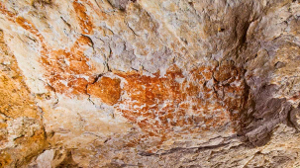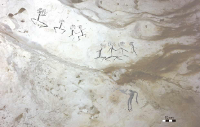|
40,000-year-old Cave Art Found in Borneo
November 7, 2018
Scientists have found what they say is a 40,000-year-old drawing of an animal on the wall of a cave in Borneo. That animal is one of three on a wall in the Lubang Jeriji Saléh cave in the province of East Kalimantan. A French explorer, Luc-Henri Fage, discovered the prominent rock art in the region in 1994. The most well defined animal, painted in reddish orange, resembles banteng, a species of wild cattle that can still be found on Borneo, the world's third-largest island. The depiction includes a streak of ochre that resembles a spear in the animal's flank. Hand stencils dot the wall near the animal depictions. Dating the artwork was a matter of calculating the age of crusts of calcite on the limestone cave walls by using radiometric dating. Also found were wall drawings of human-like figures, which the team dated to 13,600 years ago. The findings appear in the latest edition of the journal Nature. Maxime Aubert, a scientist at Griffith University in Queensland, Australia, was of the opinion that her team had found the oldest figurative cave painting in the world. Whether that is true might depend on a person's definition of art in general of figurative art in particular. The many beasts on the walls of the Chauvet cave, in France, are charcoal drawings of horses and rhinos that date to 30,000 years ago. Archaeologists have found two other, much older examples of cave art just this year:
|
Social Studies for Kids |
Social Studies for Kids
copyright 2002–2019
David White






